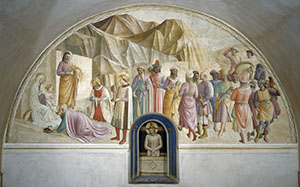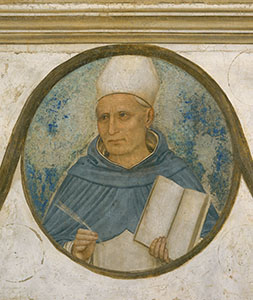
Adoration of the Magi, Museum of Saint Mark, Florence.

Crucifixion, detail of the tondo portraying Saint Albert Magnus, Museum of Saint Mark, Florence.
Originally home to the Sylvestrine Order, the Florentine San Marco monastery passed to the Dominicans of Fiesole under Pope Eugene IV in 1436.
The building, which was in extremely poor repair, was radically transformed by the architect Michelozzo on behalf of Cosimo de' Medici il Vecchio (Cosimo de' Medici the Elder). It was then decorated between 1439-1440 and 1443-1444 by the monk and painter Beato Angelico who masterfully led the works aided by several assistants, one of whom was certainly Benozzo Gozzoli. Each cell of the monastery was painted with a small fresco on a sacred and meditative theme, while the double cell (numbered 38 and 39) reserved for Cosimo de' Medici, in which Pope Eugene IV who had come to Florence to consecrate the Church of San Marco stayed over Epiphany, 1443, was adorned with a larger painting depicting the Adoration of the Magi.
Benozzo played a major role in the execution of this scene, as can be deduced by the pictorial style and more delicate colours compared to those used by Angelico as well as by the distinctly marked outline of the figures with their consequently less plastic forms. In this representation, the sacred theme of the Epiphany is set in a bare, rocky landscape that corresponds to the religious and devotional expression conceived by Beato Angelico for the whole cycle in order to enhance the spiritual content of the paintings rather than their purely decorative aspect.
The hand of Gozzoli has been recognized by Anna Padoa Rizzo also in the decorative fascia of the large lunette in the Chapterhouse where the Crucifixion is depicted; the participation of Benozzo is again revealed by the shades of colour, gestural vivacity and 'live' portrayal of reality – an aspect extraneous to the contemplative, spiritualised world of Angelico.
The work of Benozzo can also be recognised in other episodes represented in the cells of the monastery: the group of angels in prayer in the fresco of the Nativity (Cell 5), the Suffering of the Virgin in Cell 7 containing Christ Mocked, the group of The Maries at the Sepulchre (Cell 8). Lastly, also attributable to Benozzo are parts of the Madonna Enthroned and two saints (Cell 11), in scenes of Christ in the Olive Grove (Cell 34) and of the Kiss of Judas (Cell 33) and in the Crucifixion (Cell 23), in which the angels themselves, not his Roman executioners, nail and pierce the body of Christ.
Serena Nocentini